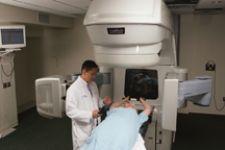
CentraState's radiation oncology staff
CentraState Medical Center, a 270-bed acute care facility, belongs to CentraState Healthcare System, a nonprofit community health organization that has served Freehold, NJ since 1971.
CentraState’s Radiation Oncology Center opened its doors in April 2002 and, in 2006, was reaccredited by the American College of Radiologists (ACR) for three years. The program was also selected as one of 60 clinical trial sites in the nation by the Cancer Trials Support Unit of the NCI and The Cancer Institute of New Jersey’s Oncology Group.
The center is a clinical research affiliate of The Cancer Institute of New Jersey, an NCI-designated comprehensive cancer center. Its cancer program is designed to bring hope to patients through a continuum of world-class services, including radiation therapy.
As part of this program, CentraState offers an advanced cancer treatment facility staffed by radiation oncology experts working with pathologists, hematologists, oncologists, surgeons and other cancer specialists. This skilled team works closely to make sure each patient receives the highest quality care available anywhere.
Recently, CentraState has taken steps to improve patient care through image-guided radiation therapy (IGRT), an emerging method of radiation therapy that enables physicians to deliver higher doses of radiation to eradicate tumors while limiting side effects. It implemented its first IGRT solution in June 2005, upgrading an existing Varian linear accelerator to the 4D Console with On-Board Imager (OBI). In June 2006, the center added cone-beam computed tomography (CBCT) capability to the same accelerator.
To sequence radiation therapy treatment on this equipment, CentraState uses an integrated clinical and administrative information management solution from IMPAC Medical Systems Inc. that is designed specifically for radiation oncology. This image-enabled electronic medical record (EMR) helps them coordinate and streamline the entire radiation therapy process, supporting independent validation, automatic setup, accurate delivery and thorough documentation.
From the outset, it was critical for the image-enabled EMR to support treatment delivery systems from multiple vendors. “We were already planning to implement the 4D Console and OBI when we decided to convert to the IMPAC system, so support for the new image-guided technology was critical,” said Jan Dragotta, clinical director of Radiation Oncology. “I was impressed by how smoothly we were able to make the transition to the 4-D. In less than a month we were already treating 30 patients a day and our productivity continued to improve.”
The OBI is an automated system for IGRT that enables clinicians to obtain high-resolution X-ray images to pinpoint tumor sites, adjust patient positioning and complete treatment within the limits of typical treatment scheduling demands. Specifically, patients are imaged, positioned and treated in 15 to 30 minutes. Reconstruction of the cone-beam image takes approximately one minute.
Moving to the OBI made sense for CentraState because it aligned with the needs of the patient population.
“With 30 percent of our patients being treated with intensity modulated radiotherapy (IMRT) — and therefore requiring pre-port setup fields — we needed to implement OBI as well as manipulate and store images into an image-enabled oncology chart,” said Dragotta. “Now — even more than when we made the initial decision to move to IMPAC as an oncology management solution — we appreciate the value of an independent verification solution, which provides us with choice and flexibility in our equipment purchases.”
Dragotta is also excited about the potential that CBCT capabilities bring for cancer patients at CentraState. This high-tech diagnostic tool acquires images while a patient is on the treatment table awaiting radiation therapy. These images help clinicians identify and compensate for minor variations in the location and size of tumors that can change from day to day.
“CBCT quickly produces detailed three-dimensional images that are used to verify tumor location and proportions,” Dragotta said. “Clinicians can compare the daily CT images to existing reference images and make necessary adjustments to the patient’s positioning to match the treatment plan. They also can use the images to modify the original treatment plan as needed.”
The image-enabled EMR also supports image-guided treatment management, or IGTM, an IMPAC solution in which a single integrated system manages the workflow for the complete IGRT process. The IGTM solution can bring images and information that are typically distributed across multiple systems into a single database that can be accessed anywhere by authorized users.
The IGTM solution must be able to connect with imaging and delivery systems from virtually any equipment vendor. This is why the image-enabled EMR at CentraState features a fully open, nonproprietary design that allows the facility to select the products that best match patient needs.
The benefits of the IGTM solution with multivendor IGRT support for CentraState and other facilities are considerable.
During planning, images from multiple modalities are available to authorized users, along with demographic and diagnostic data for each patient, anywhere on the network. Physicians can use this information to develop and simulate treatment plans, spending more time treating patients and less time trying to locate images, data and/or paper documents.
Everything team members need to approve and implement treatment plans is also available anywhere on the network. This helps ensure that all team members are working with the same images, information and treatment plans.
The IGTM solution also allows physicians, physicists and therapists to record and review the specifics of each treatment. Team members have instant access to images, blood work, nursing notes and other data for offline adaptive reviews. All the information physicians need for offline adaptive therapy can be consolidated into a comprehensive electronic patient record.


